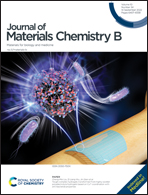Protein–inorganic hybrid porous scaffolds for bone tissue engineering†
Abstract
Porous scaffolds hold promise in the treatment of bone defects for bone tissue engineering due to their interconnected porous structure and suitable mechanical properties. Herein, LAPONITE® (LAP), which is able to promote osteogenic differentiation, was introduced into regenerated silk fibroin (RSF) porous scaffolds. Due to hydrogen bonding and electrostatic interactions between RSF and LAP, RSF/LAP 3D porous scaffolds were successfully prepared. The pore size, porosity, and mechanical properties of the RSF/LAP 3D porous scaffolds were modulated during the preparation process. Evaluation of the proliferation of bone marrow mesenchymal stem cells (BMSCs) on the RSF/LAP 3D porous scaffolds in vitro indicated that the addition of LAP improved the adhesion and proliferation of cells. Additionally, alkaline phosphatase activity and osteospecific gene expression analysis showed that the RSF/LAP 3D porous scaffolds enhanced the osteogenic differentiation of BMSCs compared to the pristine RSF porous scaffolds, especially with a higher LAP content. The subcutaneous implantation of the RSF/LAP 3D porous scaffolds in rats demonstrated good histocompatibility in vivo. Therefore, RSF/LAP 3D porous scaffolds with good biocompatibility and biodegradability have good application prospects in the field of bone tissue engineering.



 Please wait while we load your content...
Please wait while we load your content...